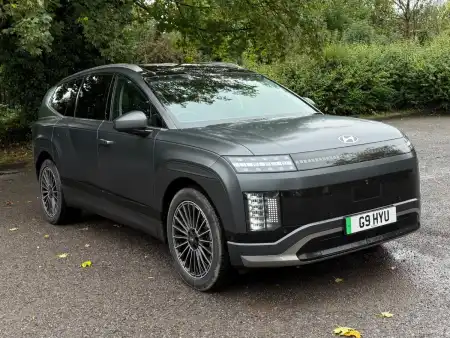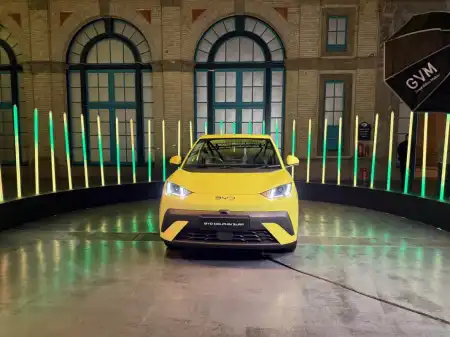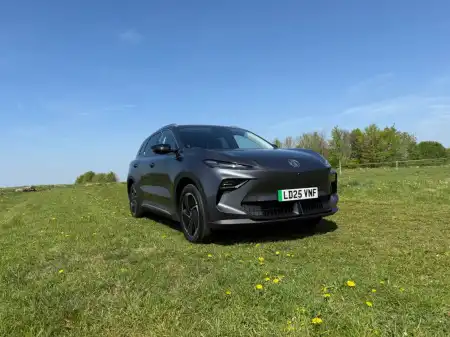- Good performance
- Keen handling
- Good looks inside and out
- Firm ride
- Less practical than rivals
- High running costs
Introduction
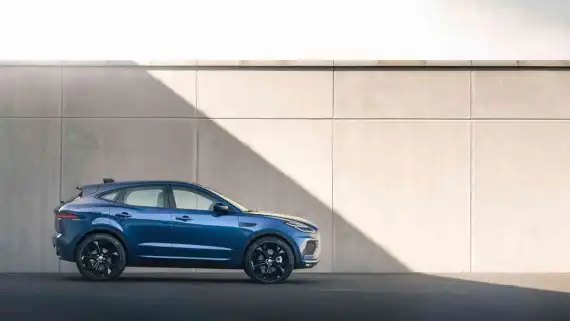
Jaguar’s E-Pace was the second SUV to join the range after its unveiling in 2017, following on from the larger F-Pace, which arrived a couple of years earlier.
As you’d imagine, given the popularity of SUVs generally nowadays, the E-Pace has been well-received.
It was given a facelift by JLR last year, but the changes were quite significant as it’s now based on the same PTA platform as the Range Rover Evoque.
A selection of petrols and diesels are offered, most of them with all-wheel drive.
That is the case in the model we’re testing – the P300 – with a 2.0-litre four-cylinder turbocharged petrol engine and nine-speed automatic gearbox, producing 300PS.
There are a few trim levels offered, but if you pick the P300, there’s only one to choose from: Sport.
It includes 21-inch black and silver wheels, premium LED headlights with animated indicators, automatic headlights, heated power-folding door mirrors, a powered tailgate and keyless entry.
You also get a Black Exterior Pack, which means things like the grille and the window borders are black rather than chrome.
Inside, you get an 11.4-inch PiviPro infotainment touchscreen with Apple CarPlay/Android Auto, a Meridian Sound System, and a DAB radio. You also get voice control, a central digital display, a head-up display, a wireless phone charger and Ebony DuoLeather sports seats. Furthermore, the Jag boasts suede cloth headlining, plus heated electric front seats with 12-way adjustment for the driver and 10-way adjustment for the passenger, with driver’s seat memory function.
The facelift also introduced a plug-in hybrid (PHEV) version, the P300e, but the P300 we’re testing only has mild-hybrid (MHEV) technology.
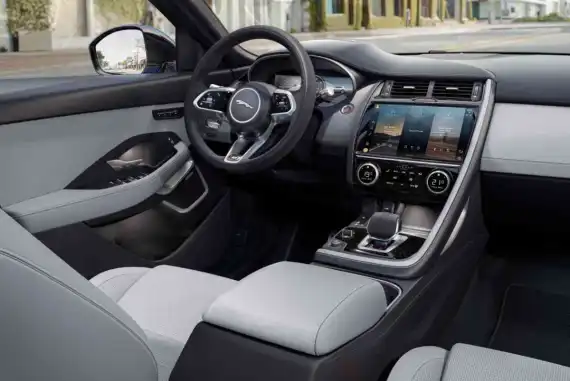
Overall, the car looks stylish but has more family-friendly and modest looks compared with the larger F-Pace, which appears more aggressive.
The E-Pace doesn’t look tame, though.
The front bumper, grille and LED headlights are a new shape, while the bodywork is sculpted around a smaller lower grille and two large air intakes.
At the sides, the size of the alloys is noticeable. There is a modest fender above the front wheel, while a crease in the lower third of the doors and a bit more sculpting beneath the back windows hints at a muscley stature.
The rear window is sharply angled, with a defining crease that points the rest of the boot vertically towards a plump rear bumper, which accommodates two tailpipes at each side.
Relatively thin taillights on either side of the numberplate and a roof spoiler peering over the back window complete the look.
Inside, the cabin layout looks smart, with plenty of silver trim on an imposing steering wheel and the large infotainment screen embedded stylishly within the dashboard.
It is a significant improvement on the old Jaguar infotainment fitted to pre-facelift versions of the E-Pace. The new one offers more straightforward menus, customisable layouts and sharp graphics.
Climate control dials and buttons sit beneath, with the selected temperature displayed digitally within the dials’ circular borders.
The passenger portion of the dash has a pillar as if to offer access mainly to the driver, although it barely obstructs the passenger's access to it and makes it more inviting and cocooning on the driver's side.
While there are plenty of premium materials, it doesn't quite match the likes of BMW for quality.
On The Road
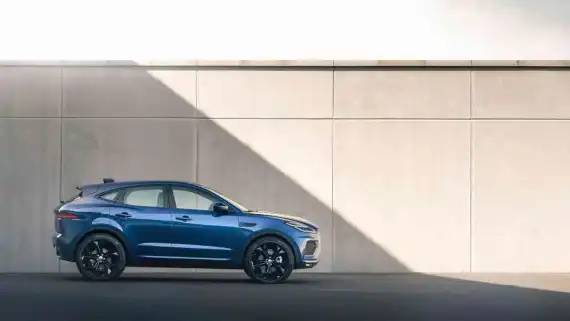
Handling & Performance
Our P300 test car gets from 0-62mph in 6.9-seconds, which is pleasant and pacey, no pun intended.
It feels brisk and, if you care about power, offers pleasing performance without the rip-roaring clout of big-engined SUVs, such as JLR’s SVR vehicles on the Land Rover side of the fence.
It is a capable powertrain and always feels like it’s got plenty in reserve for when you need it.
However, the P300e PHEV is half a second quicker to 62mph. At the same time, those seeking more traditional fuel economy may want the entry-level D165 diesel, which is a capable engine but lacks any excitement in terms of its grunt.
Arguably the best of the bunch is the D200 diesel, offering a good blend of performance and economy.
While the E-Pace isn’t uncomfortable, the ride isn’t class-leading; feeling a bit unsettled over poorer road surfaces and a little skittish at higher speeds.
The 21-inch wheels on the P300 don't help this. You can downgrade as low as 18-inches for no charge, which improves things, but if comfort’s a top priority, the E-Pace – let alone the P300 itself – isn’t the right choice.
It contrasts with the Range Rover Evoque, which uses the same platform as the Jaguar, but is more comfortable.
However, the E-Pace’s firmness means it delivers in the bends, controlling the body lean impressively for a car of its size. At the same time, the excellent steering gives you the confidence to push boundaries around corners.
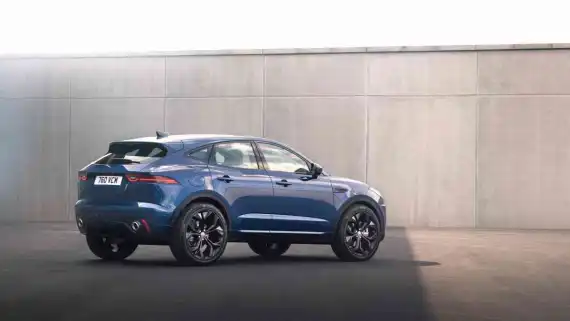
Space & Practicality
The driving position is higher than in some competitors, satisfying those who want an SUV.
Finding a good seating position is simple, too, thanks to the electric adjustment and memory settings.
Front visibility is reasonable, although the sloping roofline makes the rear pillars very thick, which heavily limits the rearward view.
There is plenty of head and legroom up front, but while the rear isn't cramped, you'll struggle to fit a trio of grownups in there, and the Volvo XC40 offers more space.
Cabin storage is good, but not exceptional, with average-sized door bins, but the cubby beneath the central armrest is accommodating.
The boot space figure is 577 litres, expanding to 1,234 litres with the rear seats down, which fold away in a convenient 40/20/40 split.
However, the layout of rivals’ boots, although smaller than 577 litres on paper, offer more practicality as they have a more practical shape.
Ownership
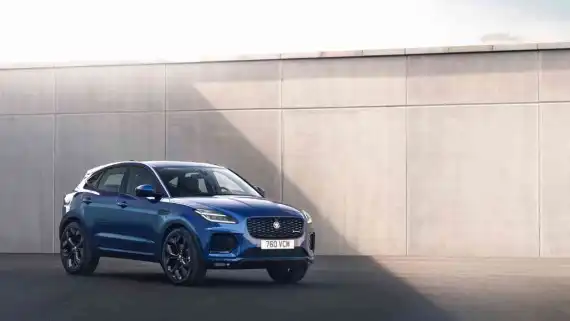
Running Costs
Fuel consumption is 29.8mpg, which isn’t bad given the size of the car and the power on offer, while CO2 emissions are measured as 214g/km.
That, however, compares to 197mpg and 33g/km of CO2 in the P300e PHEV, while the diesels manage 42-45mpg and 162-173g/km of CO2.
The P300 is the least economical by some distance, and the first year’s road tax is £1,420 (£165 a year after that) plus an extra £355 a year for the first five years because the list price is over £40,000.
So, it’s not just at the petrol station where you’ll be hit in the pocket, while today’s Benefit in Kind rates for PHEVs and electric cars make the P300 a poor choice.
You only get a three-year warranty, although at least the mileage is unlimited – and you can get extended warranties for an extra fee.
Verdict
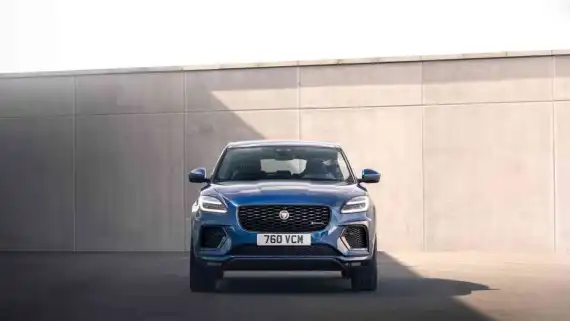
Overall, the Jaguar E-Pace is a well-tuned, well-equipped and desirable car.
The P300 is aimed at performance-seekers, though, with the other engine choices offering a more sensible blend of power versus economy.
You could have the best of both worlds with the P300e PHEV, but that’ll hit you in the pocket at the point of purchase.
Those prioritising ride comfort and practicality should know there are better options out there.
But, if you enjoy motoring and want a car that, for an SUV, is excitable to drive, the E-Pace has you well covered.

